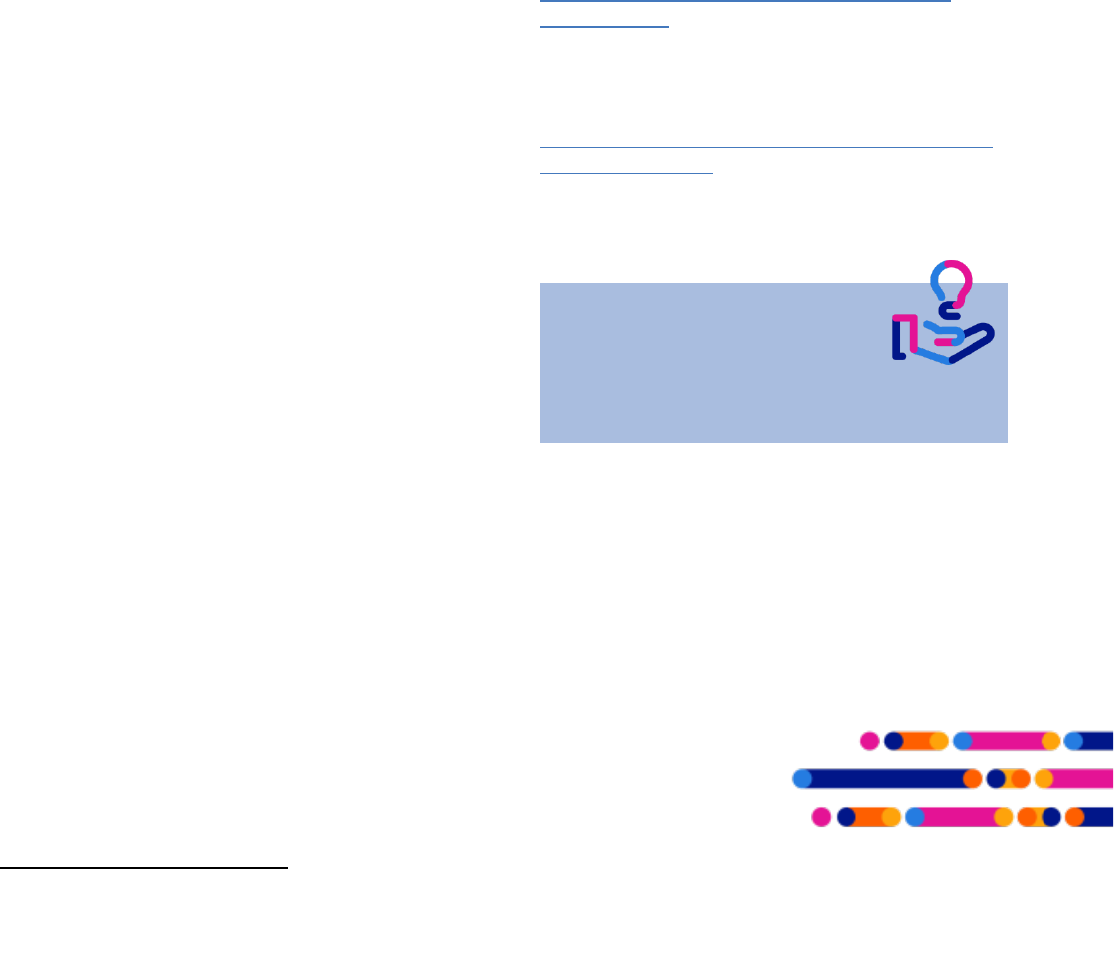
1
Demystifying Strengths-Based Services: Fostering
Refugees’ Resilience in Resettlement
Recognizing the inherent strengths of refugee individuals, families, and communities is an important starting point
for health, social work, and human service professionals. This brief information guide aims to equip those working
in U.S. refugee resettlement with evidence-informed strategies to deliver strengths-based programming.
What is a Strengths-Based Approach?
A strengths-based approach is one that focuses on
people’s resilience instead of their deficits.
1
Professionals who use this approach recognize that
all people have strengths and leverage these
assets to help individuals, their families, and their
communities succeed.
Service providers who work with refugee clients may
wish to use a strengths-based approach for a variety
of reasons. First, focusing on resilience engenders
trust and strengthens the client and provider
relationship. This approach also has the potential to
1
Pulla, V. (2017). Strengths-based approach in social work: A distinct ethical advantage.
International Journal of Innovation, Creativity, and Change, 3
(2), 97-114.
Three Strengths-Based
Questions to Ask Clients
1
1. What has worked for you
before?
2. What does not work for you?
3. What might work for you in the
present situation?

2
enhance refugees’ overall wellbeing by celebrating
their unique strengths and cultural assets and by
helping them identify their long-term goals in
resettlement. Finally, using a strengths-based
perspective provides an opportunity to identify
supportive resources in refugees’ families and
communities.
Recognizing and Fostering Resilience
Resilience has been referred to as “ordinary magic,”
2
meaning that all individuals possess the capabilities
needed to overcome adversity. Service providers are
in a unique position to work with clients to identify
resilience-promoting resources in their families,
communities, and networks as well as to remind
clients of their own strengths.
Although this is not an exhaustive list, there are
several common factors that strengthen refugees’
resilience in post-migration settings.
Factors that Promote Refugees’ Resilience
3
Individual Factors
Proficiency in host country language
Spirituality or faith in a higher power
Previous experiences
Family & Household Factors
Support from family members
Performing meaningful household roles
(especially for refugee elders)
Success of younger generations
Community Factors
Friendship and support from peers, especially
those from one’s ethnic community
Support and guidance from religious leaders
and communities
Ongoing support after the initial
resettlement period
Cultural, Political, & Eco-Social Factors
Ability to maintain cultural and religious
traditions
National policies that support integration
4
2
Masten, A. S. (2001). Ordinary magic: Resilience processes in development.
American Psychologist, 56
(3), 227-238.
3
Tippens, J. A. (2019). Urban Congolese refugees’ social capital and community resilience during a period of political violence: A qualitative study.
Journal of Immigrant & Refugee Studies
. Advance online publication. doi:10.1080/15562948.2019.1569744.
4
Adapted from Green, B. L., McCallister, C. L., & Tarte, J. M. (2004). The strengths-based practices inventory: A tool for measuring strengths-based
service delivery in early childhood and family support programs. Families in Society, 85(3), 326-334).
10 Principles for Implementing
Strengths-Based Practices
4
1. Be empowering. Base services on strengths,
not deficits. Work with clients to identify their
strengths and their ability to solve problems.
2. Be culturally humble. Recognize culture as a
source of strength. Help clients maintain cultural
traditions while adjusting to a new place.
3. Build supportive relationships between
program staff and clients, their families, and
their communities.
4. Improve relationships within and across
families and communities. Identify ways to
strengthen refugees’ supportive networks.
5. Develop and expand community
engagement and outreach efforts as you
work to recognize clients’ supportive networks.
6. Be sensitive to refugee communities’
different histories and socio-political
contexts and acknowledge how these
contribute to both challenges and strengths in
resettlement.
7. Build relationships and coalitions with
service providers outside of refugee
resettlement to ensure clients and their families
are supported beyond the initial resettlement
period.
8. Partner with refugee families and
communities to identify and solve
problems.
9. Identify goals. Work with individuals, families,
and communities to identify their goals. Then
help them identify stepping stones to meet
these goals.
10. Adapt services to meet the diverse needs and
strengths of individuals, families, and
communities.

3
Strengths-Based Practices and Strategies
Evidence to support programs and interventions that
promote refugees’ health, psychosocial wellbeing,
and integration in a real-world context is still
emerging, and there are currently no best practices
or gold standards.
5-6
Nonetheless, there are a range of “promising
practices,” or interventions that have shown success
with one or more refugee groups. The following
strengths-based practices have shown success with
refugees resettled in high-income countries. This list
is not meant to be comprehensive but rather to
provide an overview of promising strategies.
Group Models
Group models (also called group visit models) are
interventions that bring individuals together to
address a shared challenge or problem. Group
models with refugee populations, for example, have
focused on health promotion, psychosocial health,
and integration and social wellbeing.
After
completing group interventions, refugee participants
often have improved mental health (e.g., reduced
psychological symptoms), broadened friendship
networks and enhanced social support, better
quality of life, and improved English skills.
7-8
This strategy is strengths-based because it fosters
social connections, providing a space for individuals
with refugee backgrounds to exchange ideas and
problem-solve together.
The following factors should be considered when
developing group visit models:
Facilitation. Successful groups are facilitated
or co-facilitated by trained peer supporters or
lay health workers. These individuals have
shared experiences and can serve as
interpreters as well as cultural liaisons between
refugees and program staff.
Group size and composition. Most evidence
suggests that groups should be small (~5-12
5
Murray, K. E., Davidson, G. R., & Schweitzer, R. D. (2010). Review of refugee mental health interventions following resettlement: Best practices and
recommendations.
American Journal of Orthopsychiatry
,
80
(4), 576-585.
6
Richard, A. C. & Leader, K. (2018).
A case for strengthening evidence-based understanding of refugee integration.
Penn Institute for Urban Research.
7
Halcón, L. L., Robertson, C. L., & Monsen, K. A. (2010). Evaluating health realization for coping among refugee women.
Journal of Loss and
Trauma
,
15
(5), 408-425.
8
Goodkind, J. R., Hess, J. M., Isakson, B., LaNoue, M., Githinji, A., Roche, N., ... & Parker, D. P. (2014). Reducing refugee mental health disparities: A
community-based intervention to address postmigration stressors with African adults.
Psychological Services
,
11
(3), 333.
9
Sullivan, A. L., & Simonson, G. R. (2016). A systematic review of school-based social-emotional interventions for refugee and war-traumatized
youth.
Review of Educational Research
,
86
(2), 503-530.
10
Rousseau, C., Beauregard, C., Daignault, K., Petrakos, H., Thombs, B. D., ... & Hechtman, L. (2014). A cluster randomized-controlled trial of a
people) and focus on individuals with similar
characteristics to facilitate conversations among
participants. These characteristics might include
language, ethnic group, age, or individuals with
a shared experience (e.g., pregnant women).
Competing priorities. Interested and eligible
individuals may have work- and family-related
responsibilities that make it difficult for them to
participate in time-consuming programs.
Arts-Based Models
Some examples of arts-based programming to
improve refugees’ wellbeing and integration include
drawing, music, photography, quilting, creative play,
and drama interventions. These interventions have
generally focused on art therapy and have largely
targeted children, adolescents, and women.
Examples of outcomes include improved mental
health and enhanced school performance.
9
Many arts-based interventions are strengths-based
because they necessitate cultural humility by
privileging refugees’ perspectives and expertise.
Interventions that include sharing art through
exhibits or with family and community members are
strengths-based because of their emphasis on
refugees’ broader social and structural networks.
There are several factors to consider prior to
developing and implementing arts-based
programming, including:
Facilitation. Interventions in this area are
generally facilitated by art therapists.
8
Target group(s). Some arts-based
interventions have shown success with
individuals from different cultural and ethnic
groups. In one school-based study, adolescent
participants who had been raised in the host
country viewed the intervention as exacerbating
problems because it separated them from host-
country peers.
10
Extra care should be taken
when identifying participants.

4
Community Outreach & Peer Models
Finally, community outreach and peer support
models have shown success improving refugees’
health, wellbeing, and social integration. Peer
support and community outreach are separate but
intertwined concepts that are often used together to
promote refugees’ wellbeing.
These are broad umbrella terms that encompass
different models, such as community health workers
(CHWs), lay workers, patient navigators, and peer
support specialists. Peer supporters are themselves
members of the community who undergo specialized
training. These models have been used for
community development, to increase access to
health and social services, and to address health
disparities.
11-12
This approach is strengths-based because it
leverages the cultural expertise, ideas, and language
skills of community members.
The following considerations are important when
developing and implementing peer support and
community outreach programs:
Training and support. Peer supporters and
CHWs have shared cultures and experiences
with community members, often including
shared hardships and trauma. This work can be
emotionally, psychologically, personally, and
professionally challenging. Care is needed to
help peer supporters establish boundaries and
develop self-care routines while maintaining
community members’ trust. Ongoing
professional training helps enhance peer
supporters’ self-efficacy and skill-development.
Inclusion. Although peer supporters provide an
important “insider” perspective for work with
refugees, it is important to remember that no
individual person represents an entire
community. Extra care is needed to solicit ideas
and input from those whose voices may be
unintentionally excluded, including women and
elders.
classroom-based drama workshop program to improve mental health outcomes among immigrant and refugee youth in special classes. PloS One, 9(8).
11
Shommu, N. S., Ahmed, S., Rumana, N., Barron, G. R., McBrien, K. A., & Turin, T. C. (2016). What is the scope of improving immigrant and ethnic
minority healthcare using community navigators: A systematic scoping review.
International Journal for Equity in Health
,
15
(1), 6.
12
- Scott, K., Beckham, S. W., Gross, M., Pariyo, G., Rao, K. D., Cometto, G., & Perry, H. B. (2018). What do we know about community-based health
worker programs? A systematic review of existing reviews on community health workers.
Human Resources for Health
,
16
(1), 39.
Conclusion
It is important to remember that all people have
strengths. Refugee clients, their families, and their
communities have overcome tremendous hardships.
Recognizing the perseverance and resilience needed
to start over in a new place is an important starting
point when working with refugees. Strategies that
build on these strengths, rather than focusing on
deficits, have the potential to improve client-provider
trust, celebrate unique cultural assets, and support
long-term integration and wellbeing.
Resources
Centers for Disease Control Community Health
Worker Toolkit:
This online resource includes
courses, recommendations, and training materials
for community health workers (CHWs), a specific
peer supporter model.
The Guide to Community Preventive Services (“The
Community Guide”):
This free and comprehensive
online resource includes a collection of evidence-
based interventions to improve health and prevent
disease.
The IRC received $1,194,063 through competitive funding
through the U.S. Department of Health and Human
Services, Administration for Children and Families, Grant #
90RB0052. The project is financed with 100% of Federal
funds and 0% by non-governmental sources. The contents
of this document are solely the responsibility of the
authors and do not necessarily represent the official views
of the U.S. Department of Health and Human Services,
Administration for Children and Families
.
To learn more about
Switchboard, visit
www.SwitchboardTA.org.
